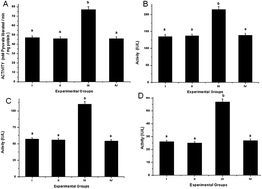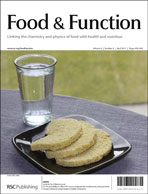Vigna unguiculata modulates cholesterol induced cardiac markers, genotoxicity and gene expressions profile in an experimental rabbit model
Abstract
Vigna unguiculata (VU) leaves are edible and used as a leafy vegetable in cuisine from traditional times in India. This study was designed to investigate the cardioprotective effect of VU in cholesterol fed rabbits. The animals were randomly divided into 4 groups of 6 animals each and the experimental period was 3 months. Group I-ND [normal diet 40 g feed], Group II-ND + FVU [flavanoid fraction of Vigna unguiculata (150 mg kg−1 per body weight)], Group III-ND + CH [cholesterol (400 mg)] and Group IV-ND + CH (400 mg) +FVU (150 mg kg−1 per body weight). After the experimental period, animals were sacrificed and the various parameters, such as cardiac markers, toxicity parameters, genotoxicity and gene expression, were investigated. Cholesterol feeding causes a significant increase in the levels of cardiac marker enzymes, namely lactate dehydrogenase (LDH) and creatine phospokinase (CPK), atherogenic index, toxicity parameters like serum glutamate oxaloacetate transaminase (SGOT) and serum glutamate pyruvate transaminase (SGPT) were elevated. Antioxidant enzyme levels were decreased, lipid peroxidation products in heart tissue and inflammatory markers, namely cyclooxygenase (COX2) and lipooxygenase (LOX15) in peripheral blood monocytes (PBMCs), were significantly increased. A genotoxicity study using a Comet assay and gene expression by reverse transcriptase-polymerase chain reaction (RT-PCR) of transforming growth factor-β1 (TGF-β1) and heme oxygenase-1 (HO-1) from heart tissue showed an altered expression in the disease group. The supplementation of the flavonoid fraction of Vigna unguiculata leaves (FVU) in the CH + FVU group caused the reversal of the above parameters and cardiotoxicity to near normal when compared with the CH group and FVU. This study revealed the cardioprotective nature of Vigna unguiculata in preventing cardiovascular diseases and this effect is attributed to the presence of antioxidants and the antihyperlipidemic properties of the flavonoid fraction of Vigna unguiculata leaves.


 Please wait while we load your content...
Please wait while we load your content...